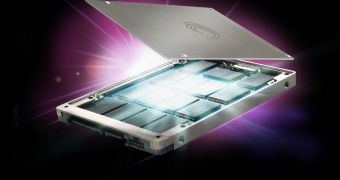Building on its experience with Blade and other enterprise server types, Seagate worked long and hard to put together a powerful and reliable solid state drive, which would offer unparalelled data reliability and security. The Pulsar single level cell NAND solid state drive does not have storage capabilities any higher than those of other enterprise SSDs or hard drives, but its unique feature, which also makes it far superior, is its ability to retain the data stored in the DRAM cache in case of power loss.
Despite the superior speeds that the drive may have been capable of had it been designed for use with the 6 Gbit/s SAS or PCIe, the Pulsar SSD works on the SATA II 3Gb/s interface. This was done in order for the drive to work on Seagate's OEMs' existing motherboard chipsets, otherwise said OEMs would have had to switch to different, more expensive server motherboards in order to support additional interfaces. Enterprises shouldn't worry, though, since the Pulsar is fully capable of 30,000 and 25,000 IOPS peak read/write speeds with 4KB blocks. This is the equivalent of 240 MB/s sequential read speeds and 200 MB/s sequential write speeds.
"Seagate is optimistic about the enterprise SSD opportunity and views the product category as enabling expansion of the overall storage market for both SSDs and HDDs," Dave Mosley, Seagate executive vice president, Sales, Marketing, and Product Line Management, said. "Our strategy is to provide our customers with the exact storage device they need for any application, regardless of the component technology used. We are delivering on that strategy with the Pulsar drive, and you can expect additional products in the future from Seagate using a variety of solid state and rotating media components."
The company has been working on this product for quite a while and select OEMs have been receiving shipments of the product since September, which means that some may have already begun to make use of the storage unit. The Pulsar comes with storage capabilities of 50GB, 100GB and 200GB and its most important feature, which ensures total data reliability, is the DRAM's aforementioned ability to retain stored data even in the case of power failures. This means that enterprises will no longer be in danger of losing valuable research data.
Seagate will be using its existing OEM relationships to promote its new product on the enterprise server market. The Pulsar will have to wrest its market share from STEC, Western Digital and Texas Memory Systems, which have already established themselves as SSD memory suppliers. Still, the mere fact that there is only a 0.44-percent annual failure rate for Pulsar will most likely enthrall the various suppliers of server solutions that worry about drops in write performance.
Seagate will start promoting the Pulsar through its rather few but powerful OEMs, such as Dell, HP, IBM, Sun, Htachi Data Systems and Acer, among others. The Pulsar has a five-year warranty, further emphasizing the high degree of data reliability it provides.

 14 DAY TRIAL //
14 DAY TRIAL //